
|
The Elyria Water Works was originally built on the shore of Lake Erie in 1904. In 1922 it was rebuilt for expanded capacity and today supplies millions of gallons of water a day to the surrounding communities. Stop 107 was located where the LSE crossed a railroad siding from the Nickel Plate railroad into the water plant. The plant's original pumps were driven by steam engines which required coal deliveries from the railroad. Electric pumps were installed later, probably during the 1922 rebuild, and coal deliveries were no longer necessary. The siding remained into the 1950's, possibly used to deliver the large quantities of sand used by the plants filters. A driveway and a strip of property south to the railroad tracks, which is still owned by the city of Elyria, marks the location of the old siding. The LSE right-of-way was long ago claimed by the expansion of West Erie Ave. Today the northern most lane of the road covers its path. A small part of old Lake Road, as it existed in the LSE days, still survives today. Renamed Pueblo Drive it is a curious little street to nowhere on the south side of the current highway. This was the location of stop 109 for the Lorain Country Club. The clubhouse sat just north of the road, between the LSE tracks and the lake, from about 1920 to 1954. The majority of the club's 43 acres of property and its nine hole golf course was south of the Nickel Plate tracks where the Sherwood allotment is today. The golf course was abandoned by the early 1940's and the clubhouse was used as a tavern until it burned in 1954. The street name comes from the Pueblo Inn, a tavern and nightclub which opened in the 1930's near stop 109 and existed in various forms until the fifties. A line of electrical poles along the north side of Pueblo Drive marks the LSE right-of-way. Undergrade The passage under the Nickel Plate Railroad tracks was known as Undergrade, and has a notorious history all its own. When the first railroad bridge was built here at the turn of the century Lake Road made a sharp, downhill "S" curve through the underpass. For the first year of operations the Lake Shore's track was laid on the road until the passage for its own right-of- way was completed on November 29, 1902. The tracks were flanked on one side by iron bridge supports and on the other by an unyielding concrete abutment. It was the site of multiple accidents over the years, caused by icy rails, brake failure, or a motorman attempting to negotiate the curves with too much speed. Several injuries and a few fatalities had already been recorded by 1926 when the worst accident occurred. On the morning of March 6 a fast moving eastbound freight train jumped the rails, struck the bridge supports, and caught fire. Motorman Edgar Crump and conductor Herbert Courtney were both killed. Their freight motor and one of the box trailers it was pulling were completely incinerated. Undergrade was extensively reconstructed in the 1950's to allow two lanes of automobile traffic in both directions. The bridge abutment and wings on the west side are believed to be the originals from 1902, but hard proof is lacking. The new road was rerouted to approach the underpass with wider, sweeping curves. A road bridge and interchange ramps for West 21st Street were built parallel to the railroad tracks, partially over the old LSE right-of-way. Just to the west is Franke Drive, which was stop 110, On-Erie-Beach. Portions of the LSE roadbed can be seen from here and a few concrete culverts still exist in the area. Oak Point Beaver Creek empties into Lake Erie at a small harbor known as Oak Point. In the 1860's Amherst quarry owner Baxter Clough built a narrow gauge railroad from his quarries to a dock at Oak Point where stone was loaded on ships to be transported throughout the region. (In 1900 the Sandusky & Interurban made plans to buy the old quarry railroad right-of-way and build a branch to Amherst and South Amherst, but the purchase never happened and the plan was shelved after the LSE merger.) In the early 1890's Oak Point Park was established here, becoming popular with local residents but also advertised widely as a resort destination by the Nickel Plate railroad which made stops here. By 1906 the resort was owned by local businessman George Blanchat and included a hotel, dance hall, pavillion, bath house, boating, bowling, and camping facilities. LSE stop 114 for the park was on the west side of Beaver Creek, what is now the intersection of Oak Point Road and West Erie Ave. The resort property was sold around 1910 amid speculation that a steel mill, oil refinery, lake port or other industry was to be built at the site. LSE management was elated at the prospect of a new city of workers and the revenue it would bring to the railway. But no industry ever developed at Oak Point and the unused resort buildings were demolished in July 1920. On the east side of Beaver Creek was an undeveloped park known as Poplar Grove, where visitors paid admission to swim at the beach or picnic and camp in the grove. In 1921 it was leased by a group of Amherst businessmen who opened it to the public under the name Beaver Park. An allotment on the south side of Lake Road was laid out with drives and lots for camping or cottages and many improvements, such as a bath house, boat dock, electric lights, and boardwalks, were added over the next few years. The LSE added stop 113½ on the east side of the Beaver Creek bridge to service this new park. In 1945 the north side of the park became Beaver Park North marina. The Copper Kettle marina and Fox Creek Golf Course now occupy the site of the Beaver Park allotment. The first LSE bridge across Beaver Creek was built in 1901 but replaced with a stronger through plate girder bridge in 1913. At that time Lake Road did not cross Beaver Creek as the present highway does but veered south, passing through what is now Beaver Park marina. In 1933 the route of Lake Road was straightened under a Works Progress Administration project. This new two lane road ran alongside the LSE right-of-way, with the railroad, electric railway, and road bridges all parallel to each other over Beaver Creek. Today the four lane highway covers both the path of the old road and the LSE. The area west of Oak Point, known as Brownhelm Bay in earlier times, featured creeks and marshes intermingled with the farms and homes of the Hahn, Claus, Kishman, and Baumhardt families. Near stop 116½ the LSE crossed Quarry Creek (also known as Claus' Creek) on an eighty-six foot long, three span steel trestle. Multiple "bypasses" under the railway allowed property owners access to the beach. The LSE right-of-way and the trestle were covered by the highway expansion in the 1950's while the farms were supplanted by Ford's sprawling Lorain assembly plant (built in 1959) and the West Lorain power plant (1967). The Last Run Lorain was the final destination when the end of the Lake Shore came. On May 15, 1938 steel coach 167 made the last passenger run, leaving Cleveland's Public Square station at 12:41 AM and arriving in Lorain just before 2:00 AM. A number of people rode the last car for the purpose of marking the occasion and saying goodbye to the interurbans. The mood was described as "a merry New Years Eve party" which became tinged with sadness as the car reached Lorain for the last time. Motorman James Trimmer and conductor E.R. Jamieson posed in a ceremonial handshake for a photographer before the car was turned on the station wye and retired to the Beach Park carbarn. Ghost Cars When the LSE folded in 1938 the entire interurban era was very near its end. Only a few LSE cars found new homes with other railways. Far more were sold at rock-bottom prices to the general public for conversion to more mundane purposes such as storage sheds, cottages, and the occasional diner. Between 1939 and the late 1960's a few of these LSE "ghost cars" could be found around Lorain. Three 1906-1907 Niles cars were used as cottages at the former stop 110, then known as On Erie Beach, now Franke Drive. A small business district arose here for a time, later fell into disrepair, and was all demolished in the late sixties. Another Niles coach, 155, served an unspecified purpose on the farm of William Miller, at the west end of Old Lake Road, west of Oak Point. By the 1960's both the car body and the farm house had been demolished to build a power station for the Ford assembly plant. Yet another Niles coach, 149, resided for several years at the old Lorain City Airport at the northwest corner of Leavitt and Meister Roads. It was moved to various other locations over the years before arriving at the Northern Ohio Railway Museum near Chippewa Lake, where it currently awaits restoration. That so little remains of the Lake Shore Electric in Lorain is ironic given the high level of activity in the city during the interurban era. Lorain and the Lake Shore Electric were immensely important to each other in the early years, but once the railway ceased operations the continuing progress of the city wiped out much of what was left. |
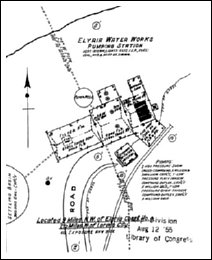
siding for coal delivery. (Dennis Lamont) |

(Dan Brady photo) |
|
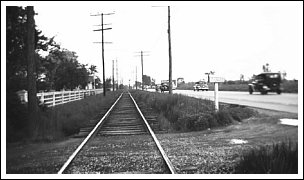
(Dennis Lamont) |
|
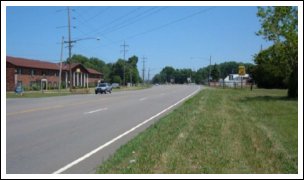
the right, modern West Erie Ave. on left. (Dennis Lamont photo) |
|
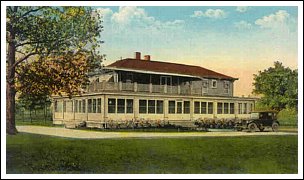
north of stop 109 circa 1920-1954. (Dennis Lamont) |
|
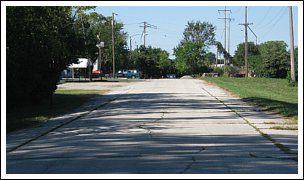
ran along the right side. (Dan Brady photo) |
|

the NKP. View is northeast in 1926. (Ralph Sayles photo) |
|
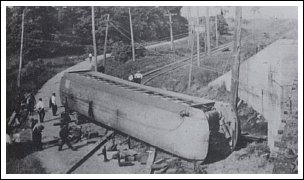
motorman Elias Hopp and a motorcyclist. (Albert C. Doane) |
|
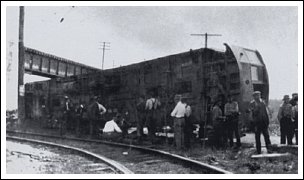
and survived far longer than the LSE itself. (Thomas Patton) |
|
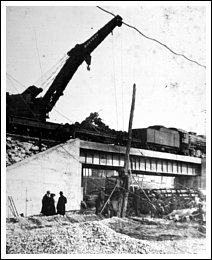
accident and fire at Undergrade. (Dennis Lamont) |

(Dennis Lamont) |
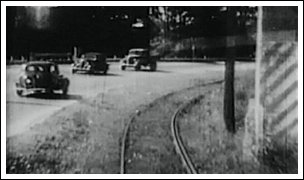
(Dennis Lamont) |
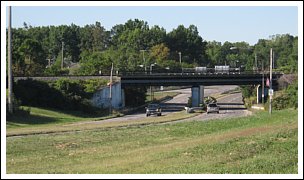
of traffic. View is to the south in 2010. (Dan Brady photo) |
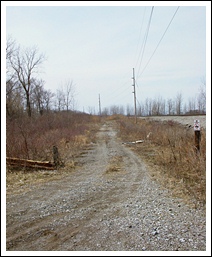
formerly stop 110 "On-Erie-Beach." (Drew Penfield photo) |
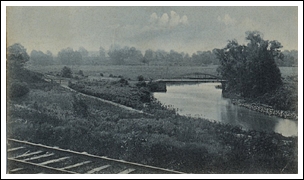
at Poplar Grove. LSE tracks at bottom of photo. (Drew Penfield) |
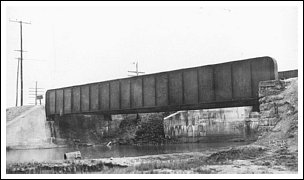
bridge is now built on this spot. (Ralph Sayles photo) |
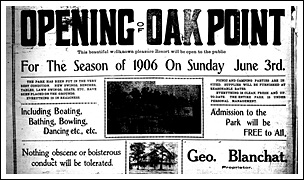
intersection of West Erie and Oak Point Road. (Dan Brady) |
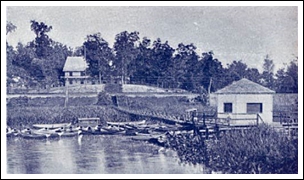
Photo from an NKP resort brochure. (NKP Historical Society) |
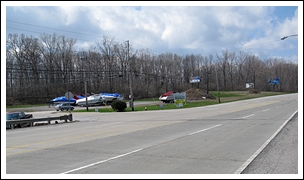
Road and West Erie Ave. in 2011. (Dan Brady photo) |
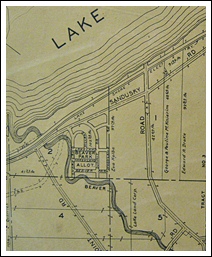
route of Lake Road, LSE, and Beaver Park. (Dan Brady) |

(Dennis Lamont) |
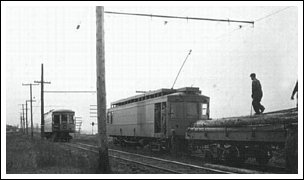
(Dennis Lamont) |
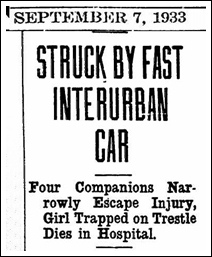
killed teenager Betty Kane near stop 116½ (Ted Reising-Derby) |
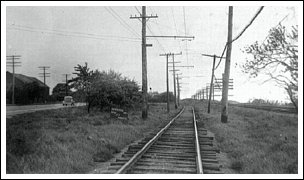
the background. (Dennis Lamont) |
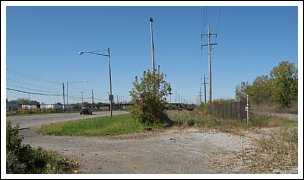
by the now defunct Ford assembly plant. (Dan Brady photo) |
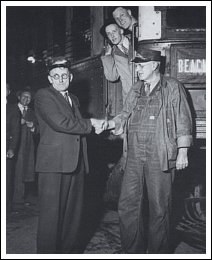
end of the last LSE run, May 15, 1938. (Thomas Patton) |

(Dennis Lamont) |
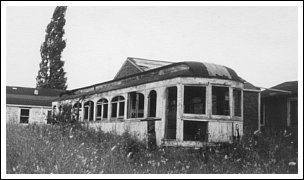
Drive until the late sixties. (Dennis Lamont) |
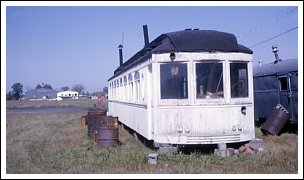
It has moved several times since. (Dennis Lamont photo) |
|
|
|